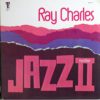“A Pair Of Threes”
Song by Ray Charles
Ray Charles recorded the instrumental jazz number “A Pair Of Threes” for his January 1973 LP Jazz Number II. The sprightly performance was the second song on Side 1, and features several nice solos and a wonderful, hip rhythm section, including drums plus bongos and Ray’s own masterful piano.
“A Pair Of Threes” was written by Alf Clausen, then thirty years old, who would go on to be a legendary television scorer, working on shows such as Donnie And Marie, Moonlighting, and, every season since its inception, The Simpsons.
A collection of musicians called The Ray Charles Orchestra is credited with “A Pair Of Threes”, although their names are not preserved on the Jazz Number II LP liner notes. So it is not known exactly who plays the solos, but if a list published on the Ray Charles Video Museum website is accurate, we can guess.
“A Pair Of Threes” begins with the jaunty rhythm section, Ernie Elly’s brushed drums laying down a groovy landscape for the scene, over which saxophones and a prominent bass (by Edgar Willis) match each other, note for note. Trumpets provide counter-melodies after each phrase.
Bongos tick away in the right speaker as the brass unites for some loud, glittering runs in the left; this part actually sounds like a TV score, for better or for worse – crowd-pleasing, somewhat broad, and undeniably fun.
The first solo comes from a saxophone; J. Lloyd Miller is credited with being the lead sax, so I’ll assume it’s him. This solo breaks from the warm brass washes that preceded it to wander agitatedly up and down the music staff, at once idiosyncratic and confident – alone but not lonesome.
Miller gives way to a soloing trumpet, assumed to be Frank Szabo. His horn emits a flurry of traditional jazz licks, super-short notes, and by the end seems to be fighting with the impatient brass underneath, which keeps popping its head up.
The melee is solved by the bass; everyone stops, except for the bongo player and Ray, whose single chords-only piano is mixed far into the background. The bass has its own agenda, and with nobody else on the soundstage to crowd him or distract him, is able to relax and enjoy itself. The electric bass notes murmur here and poke the air there; I’d like to hear a longer performance of just this, the bongos, soloing bass, and Ray’s jazzy piano chords (mixed higher though, please).
With a dramatic drum roll, everyone comes roaring back in for the end of “A Pair Of Threes”, with some nice interplay between different factions in each speaker. A decisive ending comes, the bongos rolling and the bass sputtering a few tense notes before everyone hits the last chord and falls instantly silent.
“A Pair Of Threes” is a nice performance and is structured simply but very well. The playing is great and the mix and balance are fantastic. There were no singles released from its parent LP, so to hear The Ray Charles Orchestra’s “A Pair Of Threes” look for used (or, if lucky, new) copies of the original Jazz Number II vinyl LP. They are easy to find and shouldn’t be expensive.
